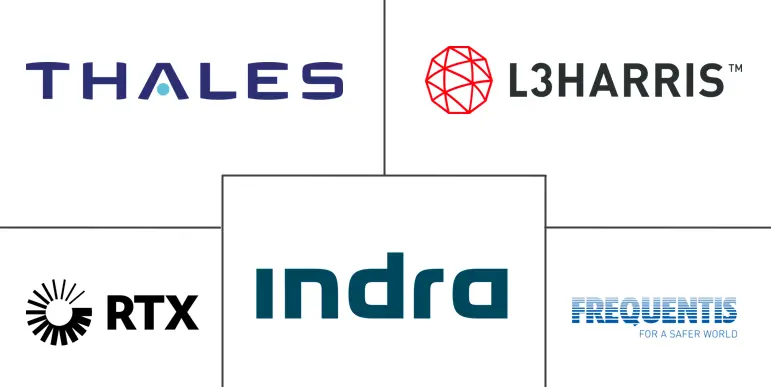Air Traffic Control Equipment Market Size and Share
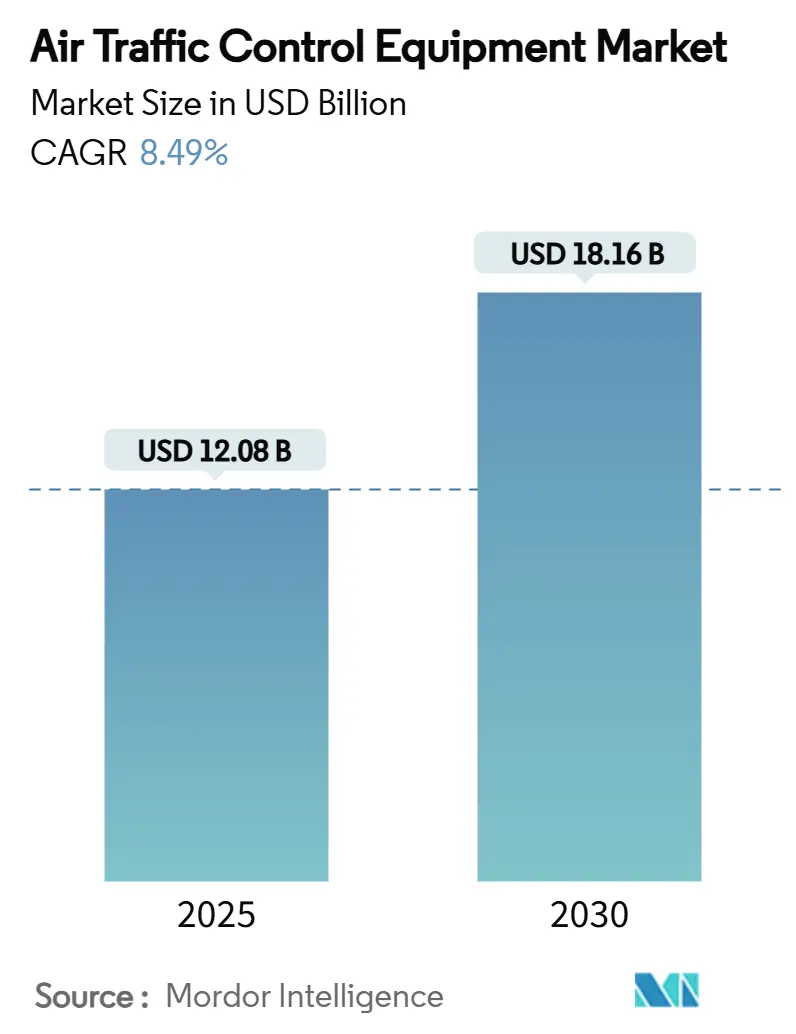
Air Traffic Control Equipment Market Analysis by Mordor Intelligence
The air traffic control equipment market size stood at USD 12.08 billion in 2025 and is projected to reach USD 18.16 billion by 2030, reflecting an 8.49% CAGR over the forecast period. The air traffic control equipment market is gaining momentum as countries upgrade their airspace systems to handle heavier traffic and strengthen safety. Public investment sits at the center of this shift. The Federal Aviation Administration allocated USD 15 billion in the United States to replace aging radars and radios, laying the groundwork for next-generation control networks. Across Asia, national programs are driving similar change. India’s One Airspace plan seeks to unify civil and military operations, while China is increasing spending on advanced surveillance and automation to meet rising flight demand. These initiatives point to a broader move toward automated, digital, and integrated monitoring that improves situational awareness and smooths traffic flows. Demand from civil aviation and defense agencies supports steady growth and continued innovation in the market.
Key Report Takeaways
- By equipment type, communication systems led with 42.50% of ATC equipment market share in 2024; remote and digital tower modules are on track for an 11.20% CAGR through 2030.
- By end user, commercial aviation accounted for 66.45% of the ATC equipment market size in 2024, while military applications are advancing at a 9.85% CAGR to 2030.
- By airport type, brownfield modernization commanded 65.60% revenue share in 2024; greenfield sites are expanding at a 9.40% CAGR through 2030.
- By investment category, modernization projects represented 58.54% of the ATC equipment market in 2024; new installations are projected to grow at a 9.45% CAGR.
- By region, North America held 40.54% of 2024 revenue; Asia-Pacific is forecasted to log the highest 10.50% CAGR.
Global Air Traffic Control Equipment Market Trends and Insights
Drivers Impact Analysis
| Driver | (~) % Impact on CAGR Forecast | Geographic Relevance | Impact Timeline |
|---|---|---|---|
| NextGen and SESAR-funded digitalization wave | 2.1% | Global, with concentration in North America and EU | Medium term (2-4 years) |
| Mandated ADS-B Out deadlines | 1.8% | North America and EU, spillover to APAC | Short term (≤ 2 years) |
| Remote/digital tower adoption at secondary airports | 1.5% | Global, particularly Nordic countries and Australia | Medium term (2-4 years) |
| Integration of UAS-traffic-management (UTM) hardware | 1.3% | APAC core, early adoption in North America | Long term (≥ 4 years) |
| AI-driven predictive airspace management platforms | 1.2% | North America and EU leading, APAC following | Medium term (2-4 years) |
| Green-flight-corridor demand for trajectory-based ops | 0.9% | EU primary focus, global adoption emerging | Long term (≥ 4 years) |
| Source: Mordor Intelligence | |||
NextGen and SESAR-funded digitalization wave
The European ATM Master Plan estimated a EUR 17 return per unit investment by 2050, encouraging authorities to channel budgets toward cloud-native, interoperable architectures. Parallel US NextGen programs prioritized satellite-based navigation, time-based flow management, and digital voice switching, locking in multiyear orders for platform suppliers.[1]Source: FAA, “AI Safety Assurance Roadmap,” faa.gov Top-tier vendors responded with Kubernetes-enabled open systems that simplify software updates and facilitate remote maintenance.
Mandated ADS-B Out deadlines
Twelve countries enforced ADS-B for defined airspace bands, sustaining retrofit demand for transponders and associated ground receivers. The FAA leveraged ADS-B data in its Surface Awareness Initiative to cut runway incursions, awarding Indra authority to roll out AeroBOSS at more than 450 airports. Europe advanced ADS-C common services under the Digital Sky framework, widening the surveillance data ecosystem.[2]Source: SESAR Joint Undertaking, “Dynamic Airspace Reconfiguration,” sesarju.eu
Remote/digital tower adoption at secondary airports
Norway’s Avinor remotely managed 21 aerodromes from one center, validating cost savings that prompted Australia to commit to a fully digital tower for Western Sydney International by mid-2026. Frequentis delivered the first US Department of Defense digital tower, proving scalability for multi-site military operations.
AI-driven predictive airspace management platforms
EUROCONTROL’s ASTRA project forecast congestion an hour in advance, while Heathrow’s AIMEE system recaptured 20% capacity lost to fog, illustrating measurable slot-use gains. The FAA’s AI Safety Assurance Roadmap sets certification pathways for machine-learning functions in design, production, and maintenance, removing a key adoption barrier.
Restraints Impact Analysis
| Restraint | (~) % Impact on CAGR Forecast | Geographic Relevance | Impact Timeline |
|---|---|---|---|
| High CAPEX and lengthy certification cycles | -1.9% | Global, particularly stringent in EU and North America | Long term (≥ 4 years) |
| Legacy-system interoperability bottlenecks | -1.4% | North America and EU legacy infrastructure | Medium term (2-4 years) |
| Escalating cyber-security liability on IP-based VCS | -1.1% | Global, heightened in developed markets | Short term (≤ 2 years) |
| Urban-corridor RF-spectrum congestion | -0.8% | Dense urban areas globally, acute in APAC megacities | Medium term (2-4 years) |
| Source: Mordor Intelligence | |||
High CAPEX and lengthy certification cycles
The US Government Accountability Office found 37% of FAA systems unsustainable, yet replacement projects often faced multi-year certification hurdles that slowed spending draws.[3]Source: US Government Accountability Office, “Air Traffic Control Modernization Challenges,” gao.gov European EASA Regulation 2023/1769 imposed design-organization approvals on ATM equipment, extending development timelines for small suppliers.
Legacy-system interoperability bottlenecks
Only 36% of control centers were IP-connected in 2024, exposing gaps when merging analog radios with Voice-over-IP routers. Gateway solutions such as Morcom’s CRU995 enabled phased cut-over but lengthened project roadmaps and raised cybersecurity risk, necessitating extra encryption layers.
Segment Analysis
By Equipment Type: Communication Systems Maintain Lead While Digital Towers Surge
Communication platforms represented 42.50% of 2024 revenue in the ATC equipment market, underlining the centrality of resilient voice channels and data links. Indra’s USD 244.3 million FAA award to supply 46,000 dual-mode digital radios illustrated replacement momentum for aging analog fleets. Vendors such as Frequentis controlled a 30% share of global controller positions, highlighting the scale economies enjoyed by established providers.
Although remote and digital tower modules account for only 5.3% of 2024 revenue, they are forecast to post the fastest 11.20% CAGR as airports consolidate surveillance under multi-airport centers. The transition reduced staffing costs by up to 30% at Nordic regional fields, bolstering return on invested capital and encouraging regulators to certify low-visibility operations using 4K sensors.
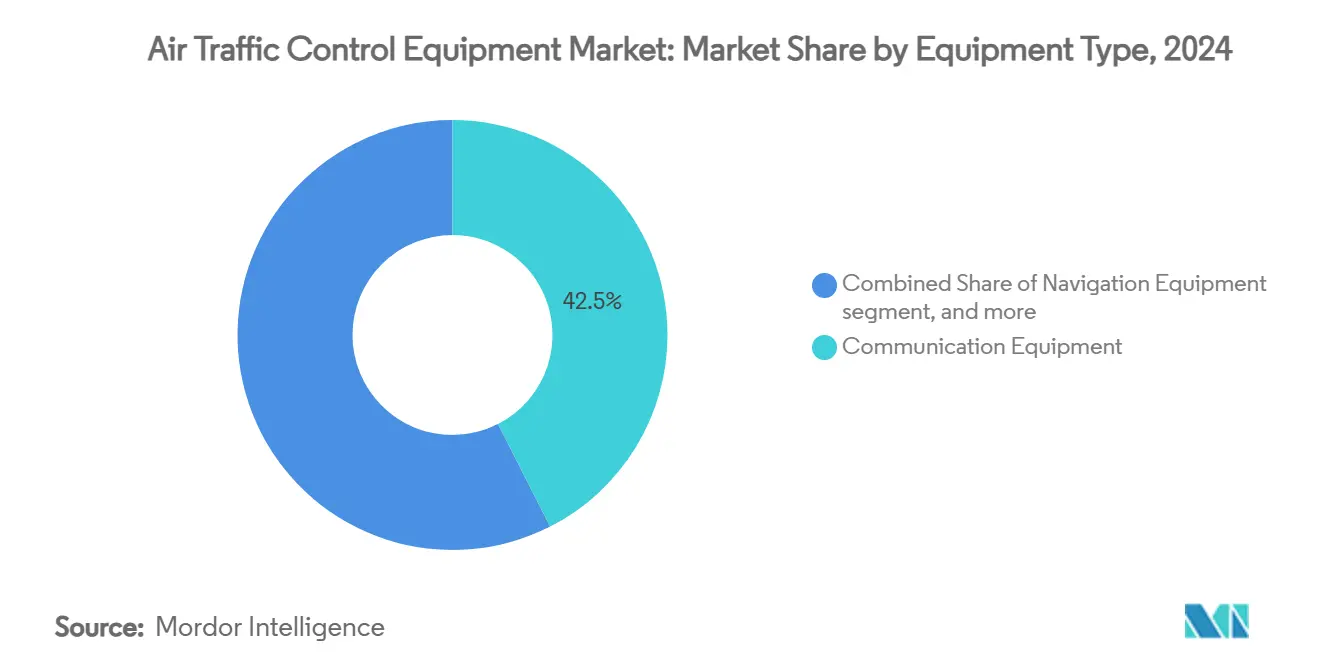
Note: Segment shares of all individual segments available upon report purchase
By End User: Commercial Aviation Dominates But Defense Drives Growth
Commercial carriers generated 66.45% of 2024 revenue for the ATC equipment market thanks to the rebound in global passenger demand and mandatory ADS-B equipage. Boeing projected Africa’s fleet to double by 2043, indicating persistent downstream demand for tower, radar, and data-link upgrades. At the same time, defense agencies accelerated procurements, lifting military revenue at a 9.85% CAGR from 2025 to 2030. A USD 472 million US Air Force order for 19 TPY-4 radars underscored the size of modernization contracts flowing into the segment.
Military applications are mirroring layered air defense priorities. Convergence between civil and defense requirements around cybersecurity, artificial intelligence, and UTM hardware continues to blur supplier boundaries and open cross-selling opportunities for integrated platform vendors.
By Airport Type: Brownfield Upgrades Dominate While Greenfield Sites Showcase Innovation
Brownfield hubs accounted for 65.60% of 2024 revenue in the ATC equipment market, reflecting decades-old infrastructure needing subsystem replacement while maintaining 24/7 operations. The FAA’s roadmap to overhaul 4,600 sites and erect six new control centers confirmed the sheer scope of deferred maintenance at legacy airports.
Though smaller, Greenfield airports are advancing at a 9.40% CAGR. Western Sydney International’s decision to run a fully digital tower from an off-site control center exemplified the blank-sheet approach that bypasses legacy constraints. Projects in Riyadh and Dubai, worth more than USD 85 billion combined, have likewise specified cloud-ready automation suites that align with net-zero operating mandates.
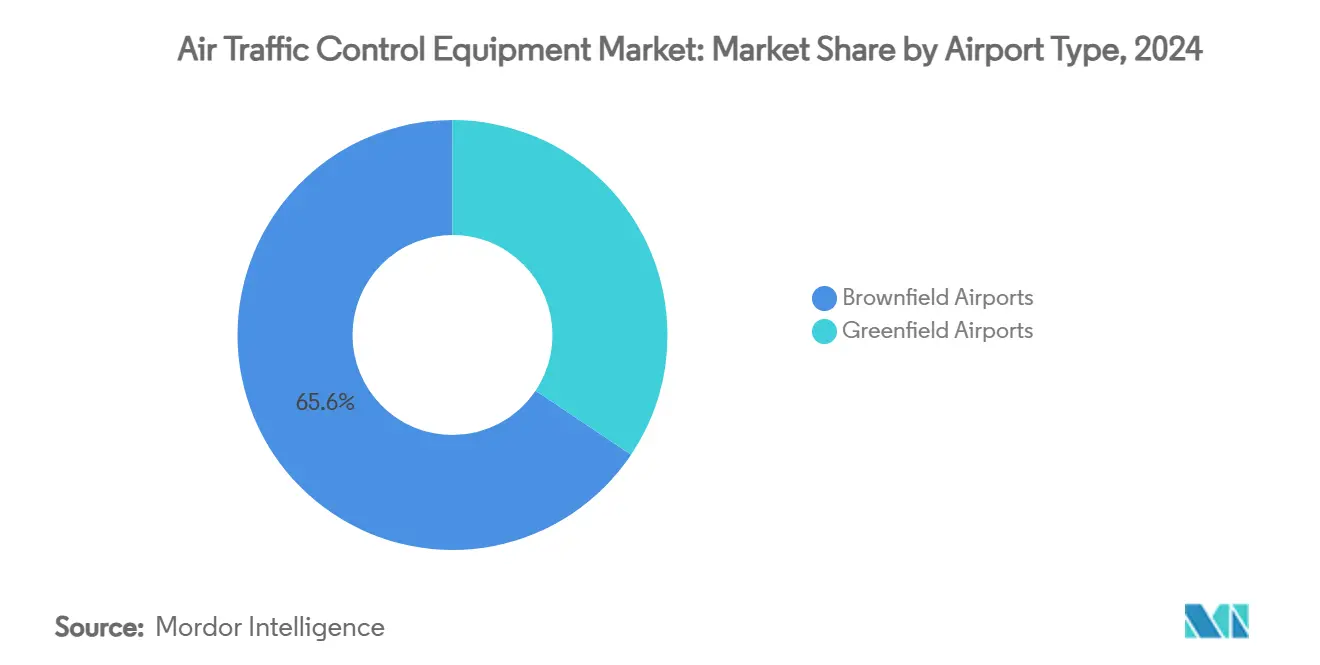
Note: Segment shares of all individual segments available upon report purchase
By Investment Category: Modernization Rules Yet New Installations Climb
Modernization captured 58.54% of 2024 spending in the ATC equipment market as aging consoles, interfaces, and primary radars neared the end of life. Indra’s upgrade of five Argentine centers with ManagAir automation provided a template for phased deployment that avoided service interruptions.
New installations are rising 9.45% annually, driven by regional passenger growth and unmanned-traffic corridors that demand standalone surveillance nodes. Thales partnered with Skyguide to introduce an open-architecture OpenSky platform that supports containerized applications, reducing hardware footprints for greenfield projects.
Geography Analysis
North America retained 40.54% of 2024 revenue in the ATC equipment market, anchored by the FAA’s USD 15 billion blueprint for digital voice switching, radar replacement, and tower construction. NAV CANADA invested in Digital Aerodrome Air Traffic Services to remotely manage isolated aerodromes, reinforcing the region’s leadership in operational innovation.
Asia-Pacific registered the highest regional growth at 10.50% CAGR. India’s “One Airspace” initiative unified 2.8 million nmi² under a single national system, while China accelerated CNS/ATM roll-outs in tandem with new runways at major hubs. Australia’s early adoption of off-site tower technology further boosted regional momentum.
Europe progressed on schedule with the SESAR 3 program, channeling EUR 30 billion into Digital Sky projects that promise 400 million tonnes of CO₂ savings by 2050. The Middle East and Africa showed pockets of intense spending, led by USD 1 trillion of airport expansions across Dubai, Riyadh, and Doha. Latin America benefited from Indra’s modernization of 70% of the region’s control centers, though funding constraints moderated its growth trajectory.
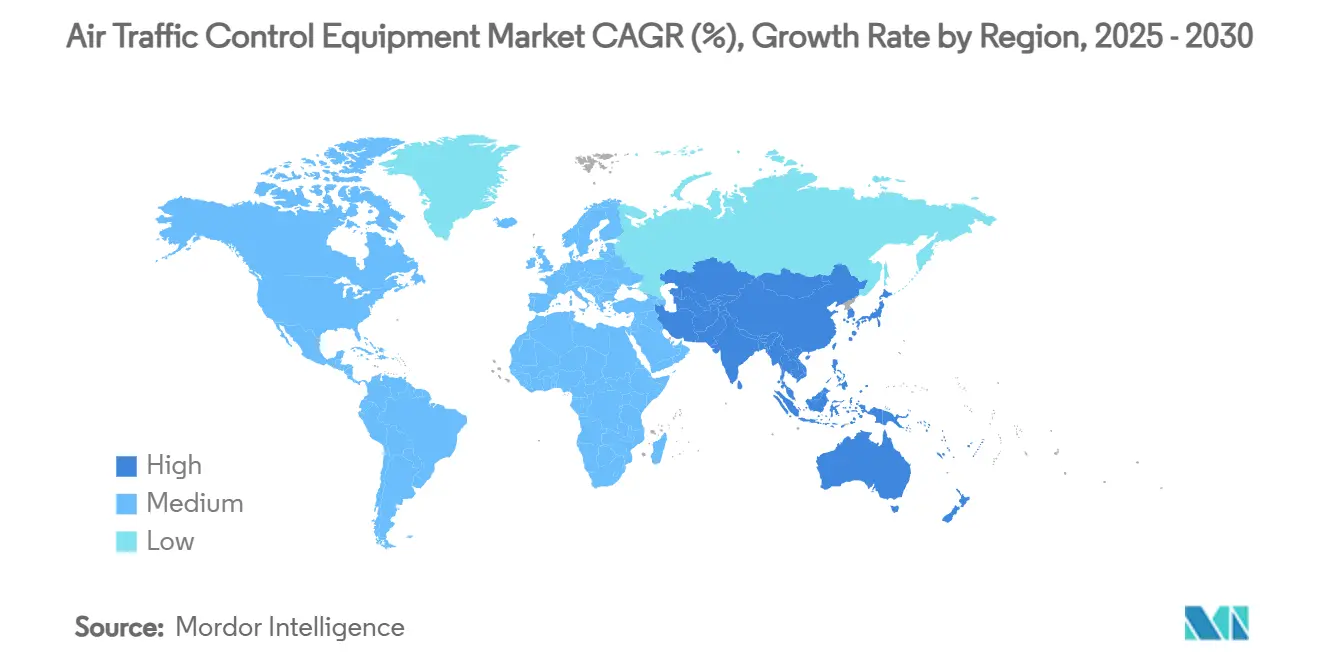
Competitive Landscape
The ATC equipment market displayed moderate concentration. Thales, Indra, and RTX Corporation leveraged decades-long domain relationships to win multi-year framework agreements, yet they faced software-centric rivals that offered cloud-native deployments at lower entry costs. Thales posted a record EUR 25.3 billion (USD 29.33 billion) order book in 2024, with air traffic systems a key contributor.
Indra lifted air traffic management revenue by 63% year-on-year during Q1 2024 after closing a USD 244.3 million US digital-radio contract and signing Canadian defense upgrades. Lockheed Martin advanced its presence with the TPY-4 AESA radar, securing multinational contracts in the United States and Sweden, emphasizing modular software updates and multi-mission capabilities.
Emerging competitors specialized in artificial intelligence and cybersecurity. NoamAI unveiled an AI-augmented controller-support suite at Airspace World 2025, while Searidge’s virtual-ramp modules integrated video analytics to improve turnaround performance at JFK’s Terminal One. The shift from capital sales to service-based subscriptions encouraged incumbents to bundle analytics, cybersecurity and lifecycle support into predictive-maintenance packages.
Air Traffic Control Equipment Industry Leaders
Thales Group
Indra Sistemas S.A.
RTX Corporation
L3HarrisTechnologies, Inc.
Frequentis AG
- *Disclaimer: Major Players sorted in no particular order
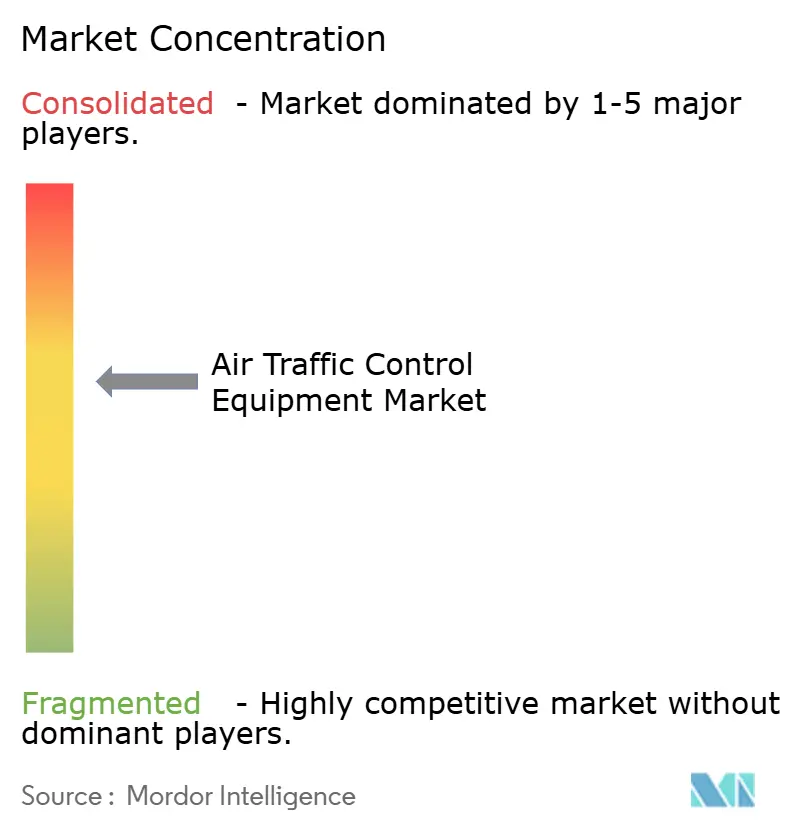
Recent Industry Developments
- April 2025: Maryland greenlit a USD 22.2 million budget for constructing a new air traffic control (ATC) tower at Martin State Airport, aiming to enhance operational efficiency and safety at the facility.
- February 2025: Canada's Department of National Defense (DND) has awarded Indra a contract exceeding EUR 13 million (EUR 15.07 million). The contract focuses on overhauling DND's ground-to-air communications. As part of this upgrade, DND will receive around 600 cutting-edge, adaptable radios, integrated with advanced technologies to bolster air traffic management and defense operations.
Research Methodology Framework and Report Scope
Market Definitions and Key Coverage
Our study defines the air traffic control (ATC) equipment market as all communication, navigation, surveillance, and tower-automation hardware that is newly delivered to civil or military authorities for guiding aircraft during approach, landing, en-route, and surface movement.
Scope exclusion: The sizing does not cover recurring software licenses, staff training services, or post-warranty maintenance contracts.
Segmentation Overview
- By Equipment Type
- Communication Equipment
- Navigation Equipment
- Surveillance/Automation Systems
- Remote / Digital Tower Modules
- By End User
- Commercial
- Military
- By Airport Type
- Brownfield Airports
- Greenfield Airports
- By Investment Category
- New Installations
- Modernization and Upgradation
- By Region
- North America
- United States
- Canada
- Mexico
- Europe
- Germany
- United Kingdom
- France
- Russia
- Rest of Europe
- Asia-Pacific
- China
- Japan
- India
- South Korea
- Australia
- Rest of Asia-Pacific
- South America
- Brazil
- Rest of South America
- Middle East and Africa
- Middle East
- United Arab Emirates
- Saudi Arabia
- Turkey
- Rest of Middle East
- Africa
- South Africa
- Rest of Africa
- Middle East
- North America
Detailed Research Methodology and Data Validation
Primary Research
Mordor analysts conducted structured talks with air-navigation service providers, airport project managers, defense procurement officials, and system integrators across North America, Europe, and Asia-Pacific. These conversations tested price corridors, project lead times, and retrofit ratios that were unclear in public data, helping us reconcile regional variances before finalizing assumptions.
Desk Research
We started with civil-aviation statistics from ICAO, FAA, EASA, and India's DGCA, then reviewed equipment import-export records in UN Comtrade and Volza to ground shipment trends. Trade association white papers from CANSO, RTCA, and EUROCAE were mined for unit-cost benchmarks and technology adoption timelines. Company filings on D&B Hoovers and news archives from Dow Jones Factiva supplied vendor revenue splits, while patent snapshots from Questel signaled upcoming subsystem launches. The sources listed illustrate the wider evidence base; many additional publications supported fact-checking and clarification.
Market-Sizing & Forecasting
A top-down build began with IFR flight movements, passenger enplanements, and planned runway additions; these were converted into demand pools using penetration rates for ADS-B, multilateration, and remote tower modules. Bottom-up cross-checks combined sampled average selling prices with radar site counts and VHF transceiver replacements to validate totals. Key inputs included mandated ADS-B-Out deadlines, national ATM-modernization CAPEX, brownfield versus greenfield airport mix, typical equipment life cycles, and currency shifts. Forecasts were generated through multivariate regression, with traffic growth, real CAPEX budgets, and equipment refresh cycles as drivers; expert panels reviewed variable trajectories before we locked the scenario. Data gaps in supplier roll-ups were bridged with channel checks and conservative uplift factors.
Data Validation & Update Cycle
Outputs pass two analyst reviews, variance checks against independent indicators, and an approval call with the domain lead. We refresh models each year and issue interim revisions when material program awards, regulation changes, or macro shocks emerge.
Why Mordor's Air Traffic Control Equipment Baseline Proves Dependable
Published estimates often diverge because providers pick different product baskets, forecasting horizons, or price assumptions. Our team states figures only after matching scope to real hardware flows and anchoring prices to signed contracts rather than list rates.
Key gap drivers include whether digital tower modules are counted, how long legacy analog systems stay in service, currency conversion dates, and the cadence at which models are refreshed. Some studies bundle consulting revenue or software subscriptions, while others omit military upgrades entirely.
Benchmark comparison
| Market Size | Anonymized source | Primary gap driver |
|---|---|---|
| USD 12.08 Bn (2025) | Mordor Intelligence | - |
| USD 10.01 Bn (2025) | Global Consultancy A | Hardware only, narrow historic window, limited primary validation |
| USD 11.79 Bn (2025) | Industry Data Provider B | Mixes software and consulting with equipment, relies on shipment multipliers |
| USD 60.80 Bn (2024) | Market Tracker C | Includes full ATM services and long-term support contracts, sparse interview input |
Taken together, the comparison shows that Mordor's disciplined scope selection, double-sourced variables, and annual refresh cadence supply decision-makers with a balanced, transparent baseline they can reliably trace and replicate.
Key Questions Answered in the Report
What is the current size of the ATC equipment market?
The ATC equipment market was valued at USD 12.08 billion in 2025 and is forecasted to reach USD 18.16 billion by 2030, reflecting an 8.49% CAGR.
Which region leads ATC equipment spending?
North America held 40.54% of global revenue in 2024, propelled by the FAA’s USD 15 billion modernization plan.
Why are digital towers gaining traction?
Digital or remote towers cut staffing costs and allow multiple small airports to be managed from one center, driving an 11.2% CAGR for this segment.
How do ADS-B mandates influence demand?
Mandatory ADS-B Out equipage created sustained retrofit sales for transponders and surveillance ground stations, lifting the market’s CAGR by about 1.8%.
What role does artificial intelligence play in air traffic control?
AI platforms forecast congestion, optimize sequences and restore capacity lost to weather, with live trials at Heathrow demonstrating 20% efficiency gains.
Which companies dominate the competitive landscape?
Thales Group, Indra Sistemas S.A., and RTX Corporation are among the leaders, supported by rising orders for fully integrated communication, surveillance and automation suites.
